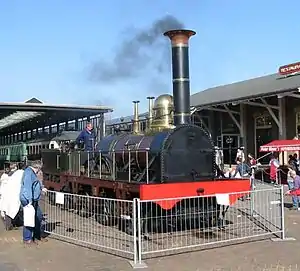De Arend (locomotive)
De Arend (Dutch pronunciation: [də ˈʔaːrənt]; the eagle) was one of the two first steam locomotives in the Netherlands. It was a 2-2-2 Patentee type built in England by R. B. Longridge and Company of Bedlington, Northumberland to run on the then standard Dutch track gauge of 1,945 mm (6 ft 4 9⁄16 in). On 20 September 1839, together with the Snelheid (Dutch for speed), it hauled the first train of the Hollandsche IJzeren Spoorweg-Maatschappij between Amsterdam and Haarlem. It was withdrawn in 1857.
| Arend and Leeuw | |||||||||||||||||||||||||||||||||||||||
|---|---|---|---|---|---|---|---|---|---|---|---|---|---|---|---|---|---|---|---|---|---|---|---|---|---|---|---|---|---|---|---|---|---|---|---|---|---|---|---|
 The 1939-built De Arend replica | |||||||||||||||||||||||||||||||||||||||
| |||||||||||||||||||||||||||||||||||||||
| |||||||||||||||||||||||||||||||||||||||
| |||||||||||||||||||||||||||||||||||||||
| |||||||||||||||||||||||||||||||||||||||
In 1939 a replica of the De Arend was constructed for the 100th anniversary of the Dutch railways. It is displayed at the Nederlands Spoorwegmuseum (Dutch Railway Museum) in Utrecht.
See also
References
- Statius Muller, R.C.; Veenendaal, A.J., Jr.; Waldorp, H. (2005). De Nederlandse stoomlocomotieven (in Dutch). Alkmaar: Uitg. De Alk. ISBN 90-6013-262-9.
| Wikimedia Commons has media related to De Arend (replica locomotive). |
This article is issued from Wikipedia. The text is licensed under Creative Commons - Attribution - Sharealike. Additional terms may apply for the media files.